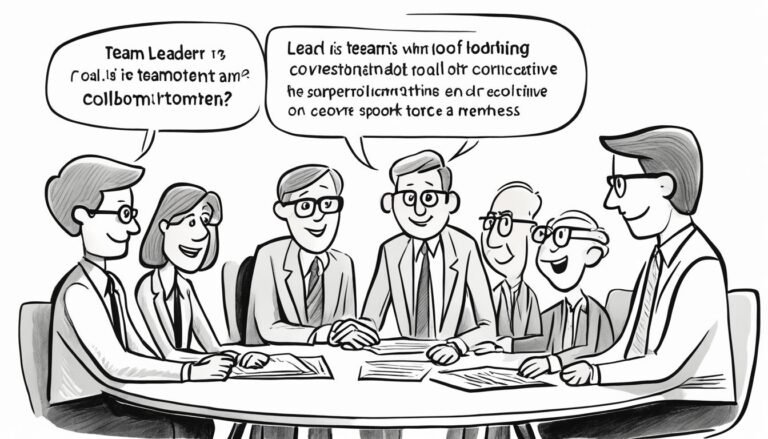Leadership Empowerment: Unlocking Potential
“The greatest leader is not necessarily the one who does the greatest things. He is the one that gets the people to do the greatest things.” – Ronald Reagan
Today, the world is changing fast and is very competitive. So, organizations and leaders see the need to empower their people. This doesn’t just create a good work vibe. It also helps to find new talent and drives success forward. To achieve this, leaders need to empower at all levels. They can do this by supporting ownership and accountability, encouraging new ideas, and teamwork. They should also aim to build trust, improve leadership abilities, and keep the work environment happy. By doing these things, they foster learning and make sure everyone is using their full potential.
Key Takeaways:
- Empowering individuals at all levels within an organization fosters a positive work culture.
- Leadership empowerment unlocks untapped potential and drives success.
- Ownership and accountability are essential aspects of leadership empowerment.
- Fostering innovation and creativity leads to greater success.
- Building trust and collaboration is crucial in empowering others.
Leadership empowerment is for everyone, not just a few. It’s about finding and using every person’s best skills. When everyone is empowered, the work culture becomes about growing together and achieving more. By empowering ourselves and our team, we can unlock amazing potential. This potential can help grow not just the team but the whole organization.
Stay tuned for the next section, where we will explore the power of empowerment in leadership and how it can transform organizations and individuals alike.
The Power of Empowerment in Leadership
Empowerment in leadership unleashes the full potential of people. It drives success in organizations. Leaders provide autonomy and the right to make decisions. This creates a culture of accountability and better work.
Empowerment aids innovation and creativity, too. When people are empowered, they feel free to share ideas. This makes the work environment richer and more dynamic. It’s a fertile ground for new, creative solutions.
Empowerment is closely tied to building trust and working together. It makes individuals feel valued and respected. This leads to stronger relationships and better teamwork. Together, people solve problems more effectively.
This approach also helps in developing leadership skills. Leaders give their team new challenges and more responsibility. This prepares team members for later leadership roles. It builds a group of strong leaders within the organization.
Empowerment makes people enjoy their work more. They appreciate having control and being trusted. This boosts their work quality and productivity. And it positively affects the organization’s overall success.
Training leaders in empowerment is key. These programs offer tools and strategies. They help create an empowering culture. This allows teams to reach their full potential.
| Benefits of Empowerment in Leadership | Empowerment Strategies |
|---|---|
| Increased accountability and improved performance | Establishing clear goals and expectations |
| Enhanced innovation and creativity | Creating a safe environment for idea-sharing |
| Stronger trust and collaboration | Promoting open communication and transparency |
| Leadership skills development | Providing growth opportunities and mentorship |
| Increased job satisfaction and employee engagement | Encouraging autonomy and ownership |
Empowerment in leadership changes everything. It unlocks team potential, boosts creativity, and enhances teamwork. Investing in empowerment training creates a thriving work culture. This brings out the best in everyone.
Unlocking Leadership Potential at Every Level
Leadership goes beyond those who are managers. It’s all about taking the lead at any level. By showing leadership skills, anyone can help their team and company grow.
To unleash your leadership, you must build up key skills and traits. Things like vision, good communication, and empathy are vital. They help you lead, no matter your title, and really make a difference.
“Leadership isn’t just about your job title. It’s how you act, influence, and the example you set.”
Anyone can lead by examples in their daily work. It means taking the first step, doing more than is required, and inspiring those around you. Through your influence, not your power, you can lead well.
Building Strong Teams Through Leadership
When everyone steps up to lead, teams become stronger. This happens when people work together and trust each other. They use each other’s strengths to reach their goals together.
Leadership training and team-building are key to helping people reach their potential. These activities teach people to lead better, communicate well, and work with others. They prepare you to be a better team player and leader.
Table: Leadership Qualities That Drive Team Success
| Leadership Qualities | Description |
|---|---|
| Vision | Having a clear direction and inspiring others towards a common goal. |
| Communication | Effectively conveying ideas, listening actively, and fostering open dialogue. |
| Empathy | Understanding and appreciating the perspectives and emotions of others. |
| Initiative | Taking proactive steps and being proactive in identifying opportunities and solving problems. |
| Adaptability | Being flexible and open to change, and embracing new challenges. |
| Resilience | Staying focused and positive in the face of adversity and bouncing back from setbacks. |
| Accountability | Taking personal responsibility for one’s actions and their impact on the team. |
By developing leadership everywhere, companies build a strong, collaborative culture. This leads to better teamwork, innovation, and success for the business.
In the next section, we will explore the essence of leadership that transcends titles and the impact it can have on individuals and organizations.
The Essence of Leadership That Transcends Titles
Leadership isn’t just for people with top job titles anymore. It depends on your actions and how you inspire others. Everyone can be a leader by showing initiative and making a positive difference in their work. By learning key traits and seeing the big picture, you can be a leader in any role.
Empowering leaders is crucial in today’s fast-changing world. Coaching helps people find their leadership style. They learn to lead authentically and motivate their teams.
Leadership is more than a title. It’s about influencing others and making a difference. Leaders are held to high standards, not just in their job but in always doing the right thing. And they share a clear vision with their team.
Coaching shows leaders their strong points and weak areas. This helps them become better at understanding emotions, communicating, and thinking strategically. They’re then ready to lead their teams well.
Cultivating leaders takes time and effort from many. Organizations benefit when they invest in developing their people. Such commitment leads to growth and overall success.
Leaders at any level can encourage a space where everyone feels they can make a difference. When leadership is promoted at all levels, companies become places where everyone grows and thrives.
Key Benefits of Leadership Empowerment
- Enhanced leadership skills and abilities
- Increased employee engagement and job satisfaction
- Improved team collaboration and performance
- Innovation and creative problem-solving
- Adaptability and resilience
Examples of Leadership Empowerment in Action
| Company | Leadership Empowerment Initiatives |
|---|---|
| Offers leadership development programs for employees at all levels, focusing on building essential skills and empowering individuals to lead with impact. | |
| Microsoft | Provides leadership coaching and mentorship opportunities to their employees, giving them the guidance and support needed to reach their full potential as leaders. |
| Zappos | Promotes a culture of empowerment through their “Holacracy” organizational structure, where employees have the autonomy to make decisions and contribute to the company’s success. |
Investing in leaders leads to personal and company-wide benefits. Expert coaching helps employees reach their full potential, and encourages innovation and team success.
Leading with a Vision: Crafting Your Leadership Philosophy
Crafting a leadership vision is key for improving your leadership. It helps you grow and supports effective strategies. Your philosophy acts as a map for your actions and decisions. A clear vision can motivate others and spark positive changes.
Start your vision by looking within. Reflect on your values, strengths, and areas to improve. Look at your style of leading and if it fits your goals. Knowing yourself helps you create an honest and powerful vision.
“Your vision will become clear only when you can look into your own heart. Who looks outside, dreams; who looks inside, awakes.” – Carl Jung
Defining specific goals is also vital. These should match your personal values and your organization’s goals. They give focus and show the way forward to success.
Visualizing the Future
Imagine the future you want, and this can motivate both you and your team. Envisioning success is a powerful way to encourage everyone and work towards a shared goal.
It’s also important to explain what you believe in. Your values shape how you lead and make choices. Having clear values means you lead with honesty and consistency.
“Values are like fingerprints. Nobody’s are the same, but you leave ’em all over everything you do.” – Elvis Presley
Linking your vision with your company’s aims is crucial for leading to success. When you support your organization’s goals, you help your team and the company move together towards success.
Developing your leadership philosophy is an ongoing journey. It needs you to keep learning and thinking about your actions. Leading with a vision can make you a more effective leader, benefiting your team and organization.
“The most dangerous leadership myth is that leaders are born-that there is a genetic factor to leadership. That’s nonsense; in fact, the opposite is true. Leaders are made rather than born.” – Warren Bennis
Leading by Example: Modeling Leadership Behavior
One of the best ways to motivate others is by leading. Your actions and work style can influence your team a lot. This means things like being consistent, honest, respectful, and a good communicator. Doing these things helps your team work better and be happier.
Being consistent matters a lot. If you keep to high standards and do what you say, your team will likely do the same. Showing a strong work ethic inspires them.
“As a leader, you have the unique opportunity to set the example for others. When you consistently display the behaviors you expect from your team, it establishes a standard of excellence.” – Jane Smith, CEO of XYZ Corporation
Integrity is crucial in leadership. Acting with honesty and openly means your team will trust you. This builds a culture of integrity where everyone is honest.
Treating everyone with respect is non-negotiable. Everyone should feel valued. When your team is respected, they give better ideas and work together more.
Being accountable is also important. Admitting when you’re wrong and taking responsibility is key. It shows your team that owning their actions is important, too. This leads to a team that takes their work seriously and wants to get better.
Clear communication is vital. Listening and giving feedback helps messages get across. This makes sure everyone is on the same page, which is crucial for working well together.
Building Strong Teams
Leading by example is key to a great team. Setting high standards inspires others to do their best. A group where everyone shows leadership is strong and unified.
Such teams also know teamwork is crucial. They support and help each other. This boosts innovation and makes everyone perform better.
Expert Leadership Coaching
Getting expert coaching can make you a better leader. Coaches give you personal advice to improve. They can help you see new strategies and overcome challenges.
This kind of coaching also helps identify where you need to improve. A good coach will help you make a plan and support you as you grow.
In the end, leading by example makes a real difference. Being consistent, honest, and respectful leads to a happy, effective team. Building strong teams and getting the right coaching can make you an even better leader, unlocking your team’s full potential.
Empowering Others: Lifting Others Up as a Leader
Empowering others is key to being a good leader. Leaders help create a space where everyone can do their best. They do this by giving out tasks, offering needed help, and allowing people to make their own choices.
It’s also important to support your team. You should be easy to talk to and ready to offer advice. This can help them grow and tackle tough situations. Praising their wins and celebrating together make a big difference.
“Empowerment is not about giving people power, it’s about creating an environment in which people already have power. It’s about liberating the power, intelligence, and creativity that’s already within people.” – Ken Blanchard
Empowerment brings lots of good things for everyone. People are happier and work harder because they feel their efforts are appreciated. It gives them a feeling of being a key part of the team’s success.
Also, it encourages people to think of new ways to do things and work together on them. Given the freedom, they often find smart solutions and help the team grow. This makes the team strong and the work environment friendly and cooperative.
In the end, leaders who empower others see their team members at their best. They make the organization they lead more successful and happy.
| Benefits of Empowering Others | Visionary Leaders |
|---|---|
| Increased job satisfaction and motivation | Creating a sense of purpose |
| Foster innovation and creativity | Inspiring others towards a common goal |
| Enhanced collaboration and teamwork | Building strong relationships |
| Growth and development of individuals | Investing in people |
Cultivating Leadership Skills: Continuous Growth as a Leader
To be a strong leader, you must always grow and develop your skills. Things like how you talk, solve problems, make choices, understand feelings, change easily, and settle fights are critical. These skills help leaders do their job better.
Talking well is key. Good leaders share their ideas, goals, and what they expect clearly. They also listen well and give feedback so discussions are open and honest. This helps their team work better together.
“Good communication is the bridge between confusion and clarity.”
Leaders need to solve problems and make good choices. They must handle tough times by looking at the facts, finding solutions, and including their team in decisions.
Understanding emotions is important too. Leaders who get their own feelings and others’ can control themselves better. They make stronger bonds and understand their team’s needs.
Being able to change and adapt is also crucial for a leader. It means being ready for new things, flexible, and strong when things get hard.
It’s important for leaders to know how to handle fights in their team. By talking openly, finding middle ground, and making sure everyone listens, they can create a happy and hardworking place.
Leaders can learn and get better by doing many things. Going to classes, workshops, and meeting experts helps leaders gain new knowledge and tools. Having a mentor, someone who is already a good leader, can offer much-needed advice. Getting feedback from others and thinking about your work can help leaders see where they’re doing well and where they can improve.
“The greatest leaders are always learning and growing.”
It’s vital for leaders to keep getting better. By working on their skills and looking for chances to improve, leaders can be the best they can be. They can help their teams and companies do great things.
Embracing Leadership Styles That Empower
Using leadership styles that empower is key to a positive work environment. It encourages growth, sparks new ideas, and keeps employees involved. Team members thrive under leaders who help them grow. This not only uplifts the individuals but also strengthens the team as a whole.
Empowering leaders let their teams make choices and own their tasks. This builds a culture of taking responsibility. Leaders listen and value their team’s thoughts, making everyone feel important.
This method benefits both team members and teams. It makes employees happier because they can share their ideas. As a result, there’s more creativity and innovation. Team members are encouraged to try new things and think creatively.
Also, when leaders empower their teams, the team performs better overall. Each member is supported to improve and has the tools they need. This teamwork boosts trust, respect, and clear communication. The outcome is better results and a successful team.
Choosing to lead in an empowering way also attracts and keeps top employees. When people feel valued and supported, they work harder and care more about their job. This not only raises productivity but also makes the workplace a better place.
“Empowering others is the essence of leadership; inspiring them to go beyond what they thought they were capable of, and creating an environment in which they feel empowered to grow and excel.” – John Maxwell
Building Strong Teams through Empowering Leadership
Empowering leadership helps teams become strong, adaptable, and successful. Leaders can adopt this by:
- Making sure everyone is informed and can speak up.
- Letting team members take charge of their work.
- Encouraging feedback, working together, and always learning.
- Valuing and praising each team member’s effort to create a caring culture.
- Offering chances to improve skills and reach personal goals.
With these steps, leaders can create a culture where everyone in the team shines. This leads to more productivity, better ideas, and success.
| Leadership Style | Description | Effect on Team Performance |
|---|---|---|
| Empowering Leadership | Leaders provide autonomy, support, and open communication to their team members. | Enhanced collaboration, creativity, and improved overall team performance. |
| Authoritarian Leadership | Leaders have strict control over decision-making and provide limited autonomy to team members. | Decreased collaboration, limited innovation, and reduced team morale. |
| Laissez-Faire Leadership | Leaders provide minimal guidance or support and allow team members to make decisions independently. | Inconsistent outcomes, lack of direction, and potential for decreased productivity. |
Leadership Empowerment: Unlocking Potential for Organizational Success
Being a good leader is more important than ever in today’s fast-changing business world. Good leaders help teams and companies do their best and succeed together.
Companies with strong, empowering leaders do better than others. They can find and keep the best workers. This helps them keep growing and coming up with new ideas.
When leaders empower their teams, everyone wins. Workplaces become places where people are excited to be. They are full of new ideas, teamwork, and a desire to do well.
The Benefits of Leadership Empowerment
“Leadership empowerment creates a culture where people trust each other and feel free to be innovative. When leaders support their team members and give them freedom to act, everyone does better. This makes employees happier, more creative, and work better together.” – Expert from Second Source
Empowered leaders inspire others to grow and take on new tasks. This leads to more happiness at work and a sense of pride in what people do. It also means more work gets done well.
Also, empowering leadership means everyone works together well. When leaders trust and support their teams, they share ideas easily. This kind of teamwork is great for solving problems and coming up with new ideas.
Leadership empowerment also lets a company’s workers show what they can do. By helping leaders grow, companies make sure they’ll be successful for years to come.
Unleashing Potential: Developing Future Leaders
Making new leaders is a big part of empowering leadership. Companies should offer lessons and chances to grow, helping their workers become great leaders.
The lessons focus on things like talking well, making good choices, and understanding how others feel. They make it easier for workers to become leaders who can really make a difference.
These programs also urge workers to try new things and keep learning. When companies invest in their workers this way, they create a place where people always strive to be better.
Key Elements of Leadership Empowerment
| Key Elements | Description |
|---|---|
| Autonomy | Granting individuals freedom and flexibility to make decisions and take ownership of their work. |
| Authority | Empowering individuals with the necessary resources, support, and decision-making power to achieve their goals. |
| Trust | Cultivating a culture of trust and psychological safety where individuals feel comfortable taking risks and expressing their ideas. |
| Collaboration | Promoting a collaborative environment where team members work together, share knowledge, and leverage diverse perspectives. |
| Development | Investing in leadership development programs to enhance the skills and capabilities of individuals at all levels. |
By using these elements in their leadership, companies can help their teams be more creative and successful over time.
Unlocking Potential: The Impact of Leadership Empowerment
Leadership empowerment is key in making employees do better in their jobs. When people are given the power, they work harder. They come up with new ideas to make their projects successful.
Empowering leaders also help in making teams work better together. They make the environment good for talking openly, trusting each other, and working as a team. This team spirit makes projects successful by blending everyone’s skills and ideas.
“Empowered team members feel a sense of ownership and responsibility for their projects, leading to increased motivation and drive.”
Leadership empowerment does a lot for an organization’s success. It makes people feel responsible and gives them freedom to make choices. This creates a culture where people do their best, knowing they are valued and trusted.
Organizations that focus on making leaders stronger attract the best people. They become known for being a place where everyone can grow and succeed.
Developing Leaders and Building a Strong Foundation
Helping leaders grow is crucial in making empowerment work. When companies teach and offer opportunities to grow, they’re making a solid future. These programs improve leaders and guide them to understand their strengths and what they need to work on.
Strong teams are a result of good leadership too. A good leader spots everyone’s talent, brings them together, and makes them work as one. They make sure everyone feels their work is important and appreciated.

Creating a Culture of Continuous Growth
Leadership that empowers also influences a culture always ready to learn. Through these practices, companies focus on a journey of constant improvement. Leaders support this by joining in programs or workshops to get better and unleash their full potential.
By adopting such leadership methods, organizations truly empower their people. This creates a place where everyone wants to be better, work together, and achieve great things. Leadership empowerment isn’t just about leaders or individuals; it’s about a culture of shared growth and success.
In the end, leadership empowerment really boosts how engaged people are, how well teams work, and overall success. Building leaders, forming strong teams, and promoting a culture of continuous development are important steps toward realizing the full potential of those within an organization.
Conclusion
Leadership empowerment turns the key to unlocking people’s potential. It affects individuals, teams, and whole organizations. Leaders should value traits like accountability, teamwork, and fresh ideas. Doing so helps create a great work environment that encourages progress and wins. Improving leadership skills and showing the way for others is crucial. By dreaming big and looking at themselves closely, people can lead successfully in their areas. In the fast-changing world of business, this is a must for any group to thrive.
Empowering leaders boost more than just how happy workers are and how much they care about their jobs. They also make work more productive, innovative, and full of teamwork. Empowered people take the lead, think outside the box, and really work hard for their goals. Leaders who give freedom, backing, and clear talks help people see their worth and effort. This keeps the best people coming and the success growing.
Developing as a leader never stops. It takes a constant effort to get better and grow. Leaders can do this by learning, having mentors, and listening to what others say about them. When a company makes room for leadership growth and power, it lays a sturdy base for the future. This leads to strong, lasting success.
FAQ
What is leadership empowerment?
Leadership empowerment is about allowing people to make decisions. It lets them own their work.
How does empowerment contribute to organizational success?
It creates a positive environment at work. This prompts people to do their best. It also encourages new ideas and trust. Plus, it grows leadership and job happiness. Lastly, it promotes learning.
Who can be a leader?
Anyone in an organization can have leadership skills. It’s not just for those with job titles like manager.
What traits are important for leadership?
Having a vision and good communication are essential. So are empathy, taking the first step, and being able to change. Being strong in tough times and taking responsibility are also crucial.
How can individuals develop their leadership potential?
To grow as a leader, focus on important qualities. Remember, leading isn’t linked to a position. Always learn and improve.
What is a leadership vision?
A leadership vision is your dream for your team or company. It shows your values, your hopes, and the change you want to see.
How can leaders inspire others?
Lead with integrity and set an example for your team. Be steady, fair, and respectful. Your clear and honest messages will motivate others.
How does empowering others contribute to leadership?
By giving others power, resources, and freedom, you help them do their best. Cheer them on and celebrate success. This builds a place where everyone flourishes.
Can leadership skills be developed?
Definitely, you can learn and get better at leading. Education, advice from others, feedback, and thinking about your actions can help.
What are the benefits of adopting empowering leadership styles?
Empowering leaders make work a better place. They attract great employees and keep them. They also spark creativity, new ideas, and strong team work.
Why is leadership empowerment crucial in today’s business landscape?
Empowering leaders are key in today’s fast-changing world. They help their teams and companies grow and win together.
How does leadership empowerment impact employee engagement and productivity?
When you empower staff, they become more involved and productive. They feel important, ready to bring in new ideas, and eager for success.
How does leadership empowerment contribute to individual and organizational growth?
Empowering leaders stimulate personal and team growth. They encourage key skills, support and lead others, and focus on a shared vision.








